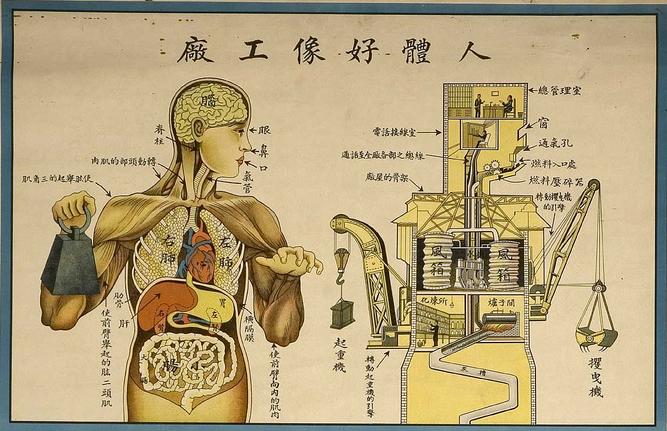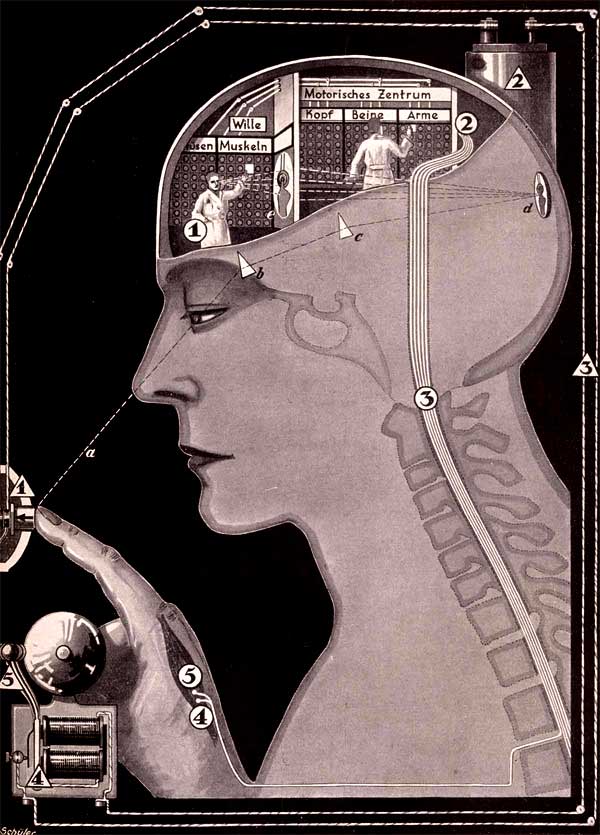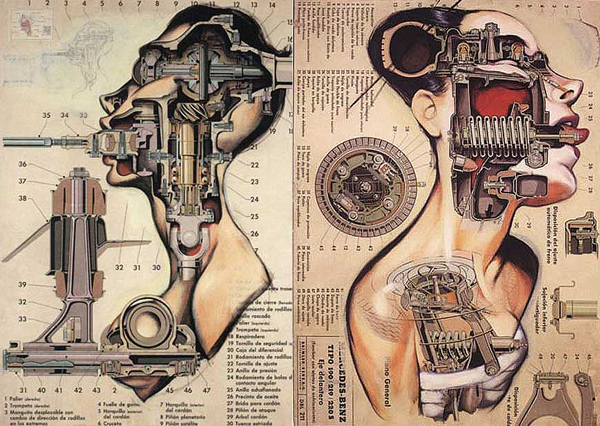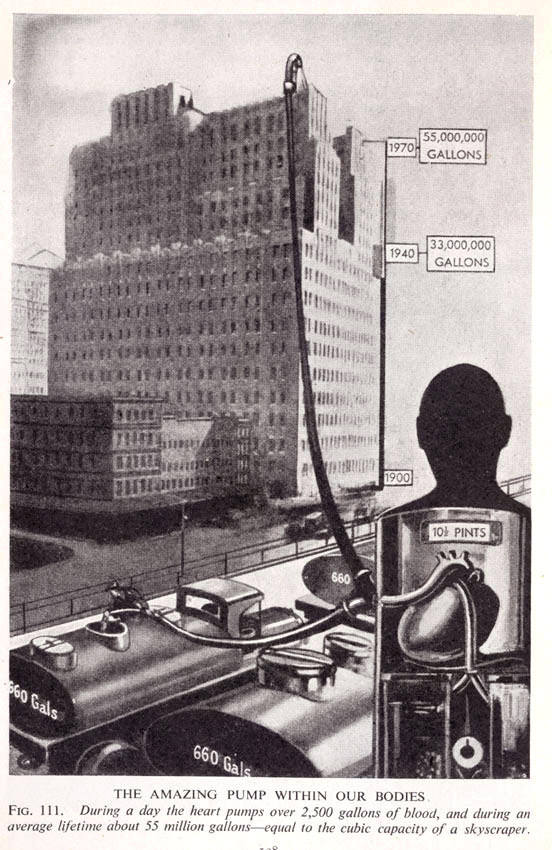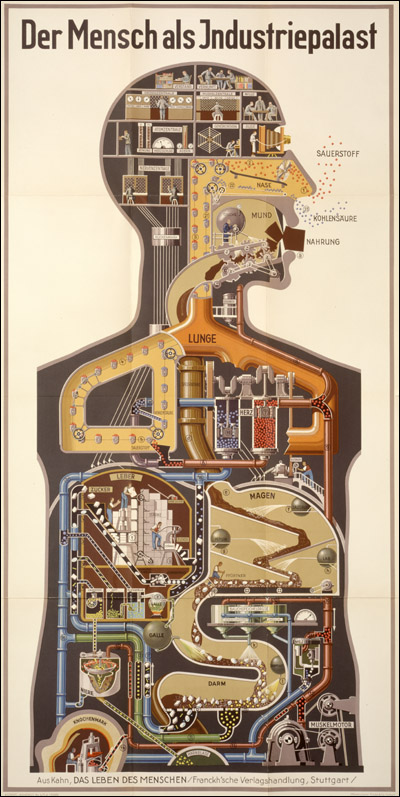The Articulations of a Body-Machine
Probe for October 10
I like to think of my body as a machine; not the hard-edged, overdetermined object that first comes to mind, but a flexible, plastic machine with moving, interchangeable parts that can be exchanged and linked together in multiple different ways. I like this image because it helps me to get over the illusion of having a distinct inside and outside, a me and not me.
Machines can be as simple as a lever and as complex as a satellite, they can be assembled, combined, and taken apart, they require maintenance, they degrade, they are energetic and transformative, they are designed to interact with other things, their borders are arbitrary, invented. From this point of view it becomes easier to reimagine everyday acts, like using my laptop, as an articulation of multiple machines, a combining of parts, with their own respective linkages and interdependencies. Through our interactions the laptop’s components and the relations between them become as much a part of my body as my fingers and veins. We share the same air, exchange heat, form feedback loops and circuits.
This text is a part of these circuits, which can be expanded to include the wooden furniture supporting our weight, the light coming in through the window, my rumbling belly, the computer’s AC adapter, the power bar, the outlet, the walls, the power lines outside my apartment, the pavement, the people who poured and patched the pavement, the people who maintain the power lines, the people who sold me the AC adapter, and beyond them, the people who mined, and soldered, assembled, and transported this laptop and its many components, which are now a part of my body and its movements, an extension of my eyes, my ears, my hands, my mouth.
This approaches what Jennifer Slack and J. Macgregor Wise call the perspective of articulation and assemblage, a perspective that sees all things as interconnected, dynamic, and contingent, a perspective that goes far beyond the temporary touching of skin and buttons, sensors and light, far beyond the confines of the apartment, and what is immediately tangible, visible, or audible.
I’m reminded of Stuart Hall’s assertion that, “The silent majorities do think; if they do not speak, it may be because we have taken their speech away from them, deprived them of the means of enunciation” (Grossberg 52).
There’s another reason I’m attracted to the idea of the flexible, moddable machine. For all its motion and dynamism, it still suggests constraint. Flexibility does not equal free reign. I can touch my fingers to the floor, but try as I might, I can’t touch my left hand to my left elbow, at least not without breaking a few bones. It’s not just physical limitations that we have to contend with, but also affective responses, such as anxiety, or disgust, and social stigmas, norms, codes, responsibilities, and regimes. For all my privilege, I am still limited in what I can do, where I can go, what I can say, limited by fear if nothing else. So the question becomes, what do I do within these constraints, how do I trace the shape of these discursive and material formations in order to push at their borders? How do I account for the fact that these formations have provided me with access to a computer, electricity, shelter, literacy, and other “means of enunciation,” at the expense of “the masses,” the silent majorities? It’s one thing to think of us all as interconnected body-machines, it’s another to imagine that these bodies are all equally positioned in relation to one another. As Slack and Wise point out, “agency is not distributed equally throughout networks” (123). Using a computer may be an everyday act for me, but it is far from everyone’s everyday.
I start with the idea of the body-machine because it allows me to trace a path, through various networks, from my current position (which shifts and multiplies along the way) to the multitude of agents that both allow me to access my objects of study, and condition my relation to them. Whatever I manage to make of those objects, it is always a result of our respective positions within a network, and the mediation of the agents and structures that make it up. Actor-Network Theory isn’t just a way of thinking about objects, but a way of thinking about ourselves thinking about, reading about, and representing objects. If the theory is aimed at discovering “how such networks get built, how they are maintained and transformed, how the articulations are made and unmade,” (Slack and Wise 121) then it seems important to acknowledge our own networked and network-building bodies as participants in those constructions and transformations.
The impulse is similar to Bruno Latour’s effort to highlight the process of discussing and institutionalizing what we typically think of as facts and values, though I take a more personal approach. This is more than just a matter of delineating research methods, and it requires more than a quick nod to subjectivity, it demands that we understand, as best we can, our own place in the constellations we are attempting to map out, and how that affects the process of mapping.
I start with my body and its articulations, rather than my intended objects of study, because it encourages me to consider how I arrived at those objects in the first place, without imagining that I am some sort of transcendental “mind” with unlimited mobility and agency. It forces me to think through my troubled relationship to Skyrim mods[1] like “Calientes Female Body Mod Big Bottom Edition” (CBBE), and “DIMONIZED UNP female body,” a relationship built both on privilege and marginalization.
Each encounter with these mods provokes a flood of associations, including plastic surgery, the fashion and cosmetic industries, reality television shows, sites plastered in pornographic ads, Barbie dolls, weight loss programs, and the many other practices, objects, discourses, and institutions that mark my body as a female body. It’s impossible for me to ignore the gendered content of these mods, even as I try to focus on the formation and circulation of the form, and broader questions surrounding neocolonialism, prosumerism and hyperconsumerism, culture jamming and the digital divide–questions which also implicate me in a sometimes-uncomfortable fashion.
This discomfort is useful, I think, as it leads me to ask, what are the rules that govern my body-machine, the rules that enable my speech, and the speech of others? What are their political implications (who or what is being suppressed, at what cost, and to whose advantage?), and how can we change them, if, indeed, we can?
Works Cited
Latour, Bruno. “A New Separation of Powers.” Politics of Nature: How to Bring the Sciences into Democracy. Cambridge: Harvard University Press, 2004. 91-127. Print.Grossberg, Lawrence. “On Postmodernism and Articulation: An Interview with Stuart Hall.” Journal of Communication Inquiry 10 (1986): 45-60.
Slack, Jennifer Daryl and J. Macgregor Wise. “Causality,” “Agency,” “Articulation and Assemblage.” Culture + Technology: A Primer. New York: Peter Lang, 2005. 33-101. Print.
[1] The Elder Scrolls V: Skyrim is a fantasy-themed action role-playing game developed by Bethesda and released in 2011. In the game players control a customizable player character (PC), which they use to interact with the environment and other non-player characters (NPCs). Some of the main activities in the game include fighting, talking, sneaking, stealing, exploring, crafting items, avoiding traps, and solving puzzles. As players engage in different activities, the player character gains experience and becomes more powerful (a process known as leveling up). The game is considered “open-world,” meaning players can travel almost anywhere in the world at any time, and are not required to follow a particular storyline or string of events. Skyrim mods are modifications of the game, typically made using the Skyrim Creation Kit software, which was released by Bethesda a few months after the game’s release. Anyone with a copy of Skyrim can download the Creation Kit software, which can then be used to change or add new content to the game. In order to access the software players must sign an End User License Agreement (EULA), which forbids modders from making money directly from their mods.
